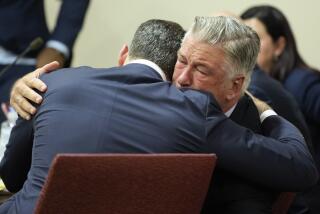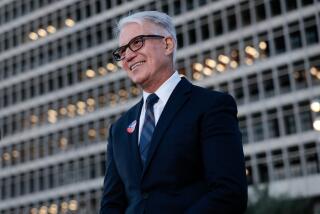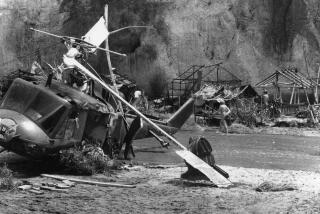‘Twilight Zone’ Defense Offers United Front During Trial
- Share via
It may have been an ideal prosecution strategy: place all five “Twilight Zone” defendants on trial together and watch them blame one another for the 1982 film set helicopter accident that killed actor Vic Morrow and two child actors.
Thus far, however, the defendants and their attorneys have largely stuck together--in the words of one lawyer, like a death-defying high-wire act in what often seems a circus-like proceeding.
“The whole case has been walking a tightrope held by all the defense attorneys,” defense attorney Arnold L. Klein asserted. “And you never know if one will let go.”
If push ever comes to shove, it is bound to occur soon. For this week, it is the turn of the seven-man defense team to take the spotlight, presenting its case of why director John Landis and four film-making associates should not be convicted of involuntary manslaughter.
On Tuesday, Los Angeles Superior Court Judge Roger W. Boren is scheduled to rule on a defense motion calling for the immediate dismissal of all charges against the five. The defense argues that Deputy Dist. Atty. Lea Purwin D’Agostino, who rested her case last week, failed to present sufficient evidence of criminal negligence despite calling 71 witnesses in 71 days of testimony since last September.
Unless Boren grants the defense motion, defense attorneys will deliver any opening statements and begin presenting witnesses Wednesday.
At this point, the defense team is reluctant to publicly outline its strategy, which could range from immediately resting its case to having all five defendants take the witness stand themselves to explain their roles in the events leading up to the gruesome accident.
Landis’ co-counsel, James Sanders, said last week that there is still a remote chance the defense might decide not to call any witnesses at all. “An awful lot of our case” has already been presented, Sanders said, as a result of D’Agostino’s strategy of calling most of the relevant film crew members as witnesses, whether or not they were hostile to her cause.
If, as expected, the defense lawyers do proceed, several certainties exist, Sanders added. For one, the defense will put on a shorter case than D’Agostino. Moreover, Sanders said, the lawyers will seek to coordinate their efforts and will proceed together on an issue-by-issue basis--for instance, calling all their scientific experts in a consecutive, logical order. Several of the other attorneys have indicated that the defense case will likely take about six weeks to two months. Among the issues they will focus on are why the two child actors, Renee Chen, 6, and Myca Dinh Lee, 7, were hired without necessary state permits; why the film makers decided to shoot the fatal accident scene, of a mock Vietnam battle, in the manner they did and why, using scientific experts, the helicopter plummeted from the sky and crashed into the actors after being struck by the fireball of a special-effects explosive.
The defense may also call to the stand both D’Agostino and the former prosecutor in the case, Gary P. Kesselman, to raise questions about their credibility and that of the initial prosecution trial witness, production secretary Donna Schuman. D’Agostino opened the door to being called to testify herself when, early in the trial, she made the extremely unusual decision to take the stand--without jurors present--after she was accused by the defense of presenting false testimony from Schuman.
Without question, the most critical strategic decision the defense faces is whether to have Landis and his co-defendants take the stand. On the surface, it might seem wise for a practiced show-biz professional like Landis to explain his side of the story. On the other hand, the defense has to consider whether the director, who has exuded a professorial air while sitting silently at the defense table, could damage his own case once he begins talking.
Moreover, if Landis does testify, D’Agostino would be allowed to cross-examine him about potentially damaging statements he made to investigators in the months following the accident. The statements were ruled inadmissible earlier unless the defendants testify.
Such decisions are never simple, but they are particularly chess-like in a multiple-defendant case.
For instance, if all five defendants take the stand, chances are higher that they might make contradictory statements. Or, worse still for the defense, they could wind up implicating each other in the tragedy.
To prevent that, the defense lawyers could decide instead to have a lone defendant attempt to explain the actions of all five. But if only one defendant, such as low-key associate producer George Folsey Jr., took the stand--as his lawyer, Harland Braun, says he will--the others could appear to be hiding something.
Further jumbling the equation is the fact that each of the defense attorneys is obligated to do whatever is in the best interest of his own client--even if it means tripping up the “high-wire act.”
Indeed, Judge Boren made reference to the issue last week, saying that before the defense begins, he wants assurances that there is “no improper co-mingling.” He asked the attorneys to lay out their plans for him “so we’re not doing some kind of a hat dance here.”
According to one prominent Los Angeles defense counsel, such “multiple-defendant cases are always a nightmare” for the defense.
“We assume jurors always want to know why defendants don’t testify, but it highlights the problem when one defendant does and the others don’t,” attorney Leslie H. Abramson said. “Or you can wind up with ‘multiple prosecutors’--all the guys on your side of the table helping prosecute your client and you prosecuting theirs.”
So far, that hasn’t happened. The primary reason they have remained united, defense counsels say, is because each believes that all five of the defendants are innocent.
“I have no doubt that (D’Agostino) expected the defendants to all point their fingers at each other and thought that’s the easiest way for her to win the case,” said Leonard Levine, who represents unit production manager Dan Allingham. But if anyone is responsible for the accident, Levine and the others say, it is special-effects employee James Camomile.
Camomile--who was granted immunity by the prosecution--has already acknowledged to the jury that he set off the fatal explosions before the helicopter was out of the way.
In their pending dismissal motion, Landis’ lawyers also note that “Mr. Camomile has admitted under oath before this court that he failed to view the helicopter’s location when he fired this mortar, and that this omission was contrary to the most basic safety requirements of his profession.”
“In the main, we’ve already got the proof out of the prosecution witnesses” such as Camomile, James Neal, Landis’ co-counsel, said last week while summarizing his view of the case. “There were safe plans, they were rehearsed, but then unforeseen and unforeseeable events occurred that caused the accident.”
Another reason for continued unity, defense attorneys say, is their mutual distaste for the fiery prosecutor. Instead of battling each other, the attorneys have engaged in a running war of words with D’Agostino, who they claim has exhibited an inflammatory, win-at-any-cost attitude.
When D’Agostino subpoenaed octogenarian actor Ralph Bellamy after he voiced pro-Landis opinions in the courtroom hallway, Braun labeled her “scum.” And when D’Agostino acknowledged to reporters that she had forgotten about an elementary legal ruling, Klein, who represents special-effects coordinator Paul Stewart, declared that she had the IQ of a radish.
Still, there are signs that what the defense lawyers have characterized as a “loose confederacy” is beginning to fray.
Last week, attorney Eugene L. Trope, who represents pilot Dorcey Wingo, filed a dismissal motion in which he appeared to cast some of the blame for the tragedy on Landis, Stewart and Allingham.
“The prosecution has established,” Trope’s motion stated, “ . . . (that Wingo) gave appropriate warnings to the (trio) and that he relied on promises and assurances by (them) that he would be out and away from the village when it would be blown up.”
Klein reacted angrily, telling reporters, “It stinks, it’s inaccurate, non-factual and mythology from a panicky defendant when he doesn’t have to be because he’s legally, factually and morally innocent to begin with.”
Trope responded calmly, saying the motion wasn’t intended “to attack anybody” and that he was not particularly concerned about Klein’s emotional response.
“This pops up every so often,” Trope said. “I think in the course of human events, there’s bound to be some friction, even between husband and wife.”
More to Read
Sign up for Essential California
The most important California stories and recommendations in your inbox every morning.
You may occasionally receive promotional content from the Los Angeles Times.










